A chimney inspection is an important diagnostic tool. Homeowners use Inspections to identify the cause of drafting issues. They also use chimney inspections to find damage in the flue liner and assess the structural stability of their chimney. At Jack Pixley Sweeps, we offer 3 levels of chimney inspections to ensure top efficiency and safety of your chimney system.
Three levels of chimney inspection
 In January 2000, the National Fire Protection Agency (NFPA) introduced three standardized levels of chimney inspection. This policy states that “Chimneys, fireplaces, and vents shall be inspected at least once a year for soundness, freedom from deposits, and correct clearances. Cleaning, maintenance, and repairs shall be done if necessary.” These standardized levels of chimney inspections help homeowners feel confident that their system is getting the proper care it needs.
In January 2000, the National Fire Protection Agency (NFPA) introduced three standardized levels of chimney inspection. This policy states that “Chimneys, fireplaces, and vents shall be inspected at least once a year for soundness, freedom from deposits, and correct clearances. Cleaning, maintenance, and repairs shall be done if necessary.” These standardized levels of chimney inspections help homeowners feel confident that their system is getting the proper care it needs.
Level 1 inspections
Level 1 chimney inspections are the most common type of inspection. We perform this level of inspection with regular chimney maintenance, or when your system is not experiencing any performance problems. During this inspection, we inspect all accessible portions of the interior and exterior of the chimney for signs of damage or deterioration.
Level 2 inspections
A level 2 chimney inspection is more intensive than level 1 inspection. In a level 2 chimney inspection, we provide an overview of the condition of the entire chimney system. We recommend level 2 chimney inspections for a new fireplace or insert installation, the relining of a chimney, or when you switched the fuel source in your system. You also need a level 2 inspection before buying or selling a home.
In the level 2 chimney inspections, we use closed-circuit cameras to view inaccessible portions of the chimney. This allows the chimney technician to view the entirety of the flue to check for cracks, damages, blockages, or other chimney issues.
Level 3 inspections
Level 3 chimney inspections are invasive. You only need this inspection if you suspect the structural stability of the chimney is in question. Typically, you will need this chimney inspection after a chimney fire, earthquake, tornado, or other natural disasters. We only use level 3 chimney inspections as a last resort, since this inspection involves removing part of the masonry or surrounding building materials such as bricks, walls, ceilings, siding.
The importance of chimney inspections
“A chimney inspection is like an annual dental check-up,” Director of Education for the CSIA Ashley Eldridge said. “It’s preventative maintenance that helps minimize potential hazards.” Chimney inspections are an important part of maintaining your chimney system. At Jack Pixley Sweeps, we meet all NFPA standards for chimney inspections. In addition, we use Chim-Scan camera systems as a part of all three levels of our chimney inspection.
A chimney inspection is an important diagnostic tool that can help identify the source of an odor. It also ensures your chimney is structurally sound and prepares your home to be sold. For more information on what type of chimney inspection your home need or to schedule your next chimney inspection, contact Jack Pixley Sweeps today!
Getting ready to sell your home is an difficult process. When a homeowner is ready to put their home on the market, hours are spent cleaning. However, there is one important place in your home that you should not overlook when cleaning – the fireplace.
If you are ready to sell your home, it is important to have a professional the fireplace and chimney sweeping and inspection. A Level II chimney inspection and report by a CSIA certified chimney sweep give potential buyers the peace of mind that the fireplace is in good condition. At Jack Pixley Sweep, all of our sweeps are CSIA certified and we have years of experience, you can trust our sweeps to put your mind at ease.
Have a professional chimney inspection before putting your home on the market
 In addition to packing boxes, staging furniture, and cleaning carpets, you should also schedule a Level II chimney inspection before putting your home on the market. Having your a chimney inspection before listing your house gives a full report of the actual state of your chimney with the disclosures of your home. More importantly, it gives homeowners a chance to make necessary repairs or changes to prevent delays during the transaction of a home.
In addition to packing boxes, staging furniture, and cleaning carpets, you should also schedule a Level II chimney inspection before putting your home on the market. Having your a chimney inspection before listing your house gives a full report of the actual state of your chimney with the disclosures of your home. More importantly, it gives homeowners a chance to make necessary repairs or changes to prevent delays during the transaction of a home.
Some of the most common problems discovered during an inspection are:
- Insufficient clearance between hot surfaces and nearby combustible materials
- Damage to the chimney liner or a liner that is the wrong size
- Flashing that has lost its watertight seal around the base of the chimney
- Moisture damage to the masonry
- Building techniques or components that are not compliant with modern safety standards and codes
What to expect during a Level II chimney inspection
During a Level I chimney inspection, which is performed during chimney maintenance, the sweep inspects all accessible interior and exterior of the fireplace. During a Level II chimney inspection, sweeps use technology such as closed circuit cameras to identify problems within the flue. Buyers may also request their own chimney inspection once the home is in escrow. This is done if there are more questions about the conditions of the fireplace, if an inspection was not done before the home was listed, or if the buyers doubt the findings of the original inspection.
Do I need a chimney inspection AND a home inspection?
Many homeowners and potential buyers believe that a home inspection spot any problems a fireplace has. While home inspectors usually identify major chimney problems such as structural instability, they often lack the training to thoroughly inspect a fireplace system. National Fire Protection Code 211 requires a chimney inspection before the sale of a home. An inspection by a certified chimney sweep can protect both the buyers and sellers during a real estate transaction.
Preparing to sell your home is stressful. having a professional chimney inspection before putting it on the market gives you and the potential buyers peace of mind. For more information on real estate chimney inspections, contact Jack Pixley Sweeps today!
Fall’s cooler temperatures are just around the corner. This year, make sure your fireplace is ready to use by having your chimney inspected before your first fire.
What is a chimney inspection?
A chimney inspection is an important diagnostic tool that can be used to identify the cause of fireplace performance problems as well as assess the condition of everything from the firebox to the flue. Chimney inspections are an important part of regular annual fireplace maintenance and are helpful in finding areas of damage or deterioration before they turn into major problems.
According to the National Fire Protection Agency, or NFPA, “Chimneys, fireplaces, and vents shall be inspected at least once a year for soundness, freedom from deposits, and correct clearances. Cleaning, maintenance, and repairs shall be done if necessary.”
Three Levels of Chimney Inspections
NFPA Standard 211 created three standardized levels of chimney inspection. Your chimney sweep can help you determine which level of chimney inspection is best for your home based on use, condition, or performance problems.
- Level I: Level I chimney inspections are the standard level of inspection for homes with fireplace in good condition that have not been modified, damaged, or experienced performance problems. During a Level I inspection, the accessible interior and exterior portions of the chimney are checked for signs of damage or deterioration.
- Level II: Level II chimney inspections are more in-depth; inaccessible portions of the flue are checked using technology such as closed circuit cameras. Level II chimney inspections are often recommended when a home is being bought or sold. Likewise, they are also used when there have been changes to the fireplace such as changing fuel sources or installing a new insert.
- Level III: Level III chimney inspections are the most in depth – and invasive. Because of this, they are only recommended in cases of severe damage or structural instability after natural disasters such as earthquakes, fires, or tornadoes. During a Level III chimney inspection, portions of the masonry, walls, or ceilings around the fireplace and chimney may need to be removed in order to fully assess the damage.
The Importance of Annual Chimney Inspections
“A chimney inspection is like an annual dental check-up,” says Ashley Eldridge, Director of Education for the CSIA. “It’s preventative maintenance that helps minimize potential hazards.”
After a summer of disuse, it is important to have your chimney swept before using it for the first time. Debris, water, and animal entry can all create chimney problems during the spring and summer; while these issues are often quickly recognized when the fireplace is being regularly used, they may have gone unnoticed during the summer. An inspection can identify these issues and allow them to be repaired – without causing further problems or damage to the chimney.
Make sure your chimney is ready for the first fire of the season by having it inspected. Contact Jack Pixley Sweeps today to schedule your fall chimney inspection and get your fireplace ready for fall.
 In January 2000, the National Fire Protection Agency (NFPA) introduced three standardized levels of chimney inspection. This policy states that “Chimneys, fireplaces, and vents shall be inspected at least once a year for soundness, freedom from deposits, and correct clearances. Cleaning, maintenance, and repairs shall be done if necessary.” These standardized levels of chimney inspections help homeowners feel confident that their system is getting the proper care it needs.
In January 2000, the National Fire Protection Agency (NFPA) introduced three standardized levels of chimney inspection. This policy states that “Chimneys, fireplaces, and vents shall be inspected at least once a year for soundness, freedom from deposits, and correct clearances. Cleaning, maintenance, and repairs shall be done if necessary.” These standardized levels of chimney inspections help homeowners feel confident that their system is getting the proper care it needs.
 In addition to packing boxes, staging furniture, and cleaning carpets, you should also schedule a Level II chimney inspection before putting your home on the market. Having your a chimney inspection before listing your house gives a full report of the actual state of your chimney with the disclosures of your home. More importantly, it gives homeowners a chance to make necessary repairs or changes to prevent delays during the transaction of a home.
In addition to packing boxes, staging furniture, and cleaning carpets, you should also schedule a Level II chimney inspection before putting your home on the market. Having your a chimney inspection before listing your house gives a full report of the actual state of your chimney with the disclosures of your home. More importantly, it gives homeowners a chance to make necessary repairs or changes to prevent delays during the transaction of a home.